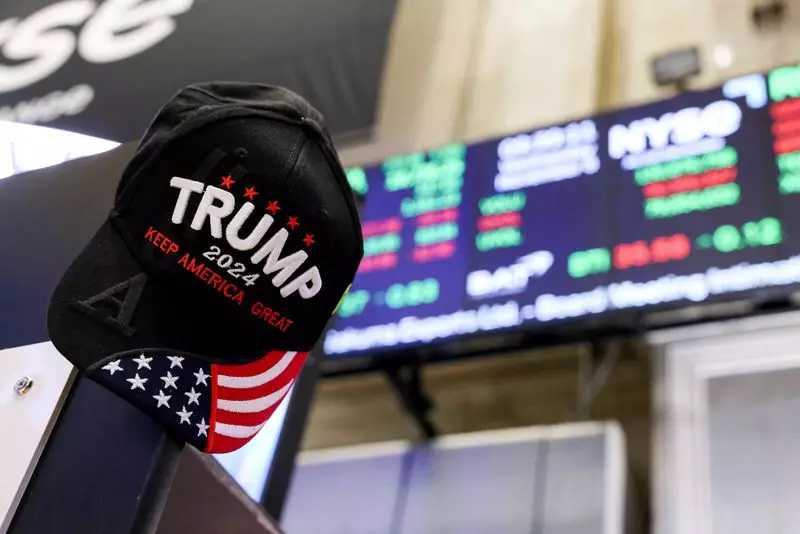On what can be described as a tumultuous Friday for Wall Street, major indices experienced a downturn as investors grappled with mixed economic data and earnings reports. The overall sentiment reflected a cautious approach as stakeholders prepared for an upcoming week laden with critical economic releases, notably the Federal Reserve meeting scheduled for January 28-29. Amidst this backdrop, the technology sector emerged as the largest contributor to market weakness, reversing gains seen earlier in the week, particularly impacting high-profile stocks such as Nvidia, a leader in AI chip production.
The housing market presented a surprisingly robust front, with data exceeding analysts’ expectations. However, an S&P Global survey indicated a slump in business activity that reached a nine-month low for January, suggesting that rising prices are beginning to exert pressure on businesses. While the reports were mixed, the signs of increased hiring within firms could lend some weight to the Federal Reserve’s predominantly careful monetary policy approach as the year unfolds.
Further complicating the economic landscape, the University of Michigan’s final estimate on consumer sentiment fell from a previous 73.2 to a more sobering 71.1. This dip in consumer confidence reflects unease regarding economic stability and hints at potential challenges for the Federal Reserve as it assesses the financial environment moving forward. Investors are consequently projecting that the Fed will maintain current borrowing costs during the forthcoming meetings, with expectations for a rate cut materializing around June, as gauged by recent data from CME Group’s FedWatch tool.
According to Scott Helfstein, head of investment strategy at Global X, the fluctuations in the market can be attributed to an amalgamation of mixed economic indicators and earnings news. “We are entering a week filled with substantial news that could sway market dynamics,” he pointed out, adding that policy uncertainties under the new Trump administration could prolong volatility.
Investor trepidation is palpable regarding President Trump’s proposed tariffs, which may potentially exacerbate inflationary pressures. Trump’s discussions of trade policy this past week, although somewhat nebulous, could affect the Federal Reserve’s timeline for rate adjustments. He has indicated a possibility of imposing tariffs on trade partners, including Mexico and Canada, with announcements anticipated around February 1. However, analysts warn that any significant trade plans might not materialize until April.
The Dow Jones Industrial Average experienced a drop of 140.82 points (0.32%) to close at 44,424.25, while the S&P 500 and Nasdaq Composite recorded declines of 17.47 points (0.29%) to 6,101.24 and 99.38 points (0.50%) to 19,954.30, respectively. Despite Friday’s declines, the week overall showed improvements in the indices, with the S&P 500 rising by 1.74%, the Nasdaq increasing by 1.65%, and the Dow up by 2.15%.
Despite the overall downturn, certain sectors displayed signs of resilience. Specifically, within the S&P 500, six out of eleven sectors recorded gains, led by communications services, which climbed by 1.09%. Furthermore, the utilities sector experienced a robust performance, highlighted by NextEra Energy Inc, whose shares surged by approximately 5.2%, marking it as the biggest day gainer within the S&P 500.
Despite recent rallies fueled by technology stocks, Friday was a tough day for the sector. Chip maker Texas Instruments notably fell by 7.2% after projecting lower-than-expected profits amid inventory challenges. Nvidia, one of the technology sector’s heavyweights, suffered a 3.1% decline, reflecting investor hesitations that overshadowed earlier weekly gains.
Other major corporations, such as American Express and Boeing, faced obstacles as well. American Express recorded a notable profit increase yet still saw its share prices drop by 1.4%. Likewise, Boeing warned of significant losses in its fourth-quarter earnings, resulting in a corresponding 1.4% decrease in its stock.
Friday’s trading session illustrated a complex interplay of economic signals as market participants adapt to evolving circumstances. Advancing stocks outpaced decliners on the NYSE with a ratio of 1.45-to-1, indicating some underlying strength despite broader market concerns. The upcoming week promises to be pivotal as the financial community closely monitors fresh data on inflation and growth, alongside anticipated changes in Federal Reserve policies.
Overall, the week saw 14.02 billion shares exchanged, marking a slight dip below the average for the preceding twenty sessions. Investors remain on edge, evaluating the implications of government policies and economic performance, while bracing for an array of financial indicators that could reshape the market’s trajectory heading into February.

